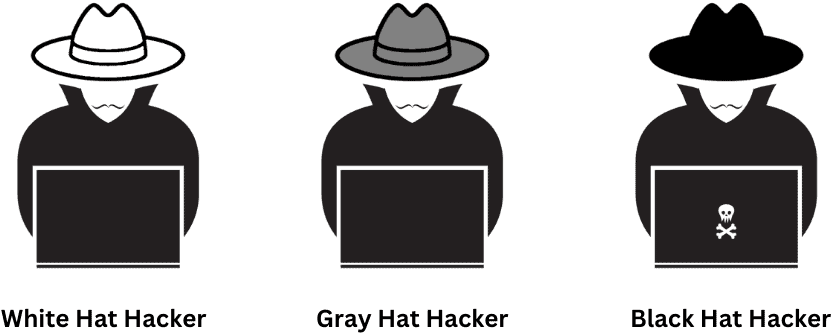1. Introduction
In this tutorial, we’ll define hackers and crackers.
We’ll understand their behavior, motives, and impact. Then, we’ll illustrate the key differences between them.
2. Hackers
Hackers have advanced technical skills and a profound understanding of computer frameworks and systems. They have expertise in various programming languages and use their knowledge to bypass security protocols and discover systems’ vulnerabilities.
Although hacking is illegal, some hackers have good intentions. Some of them are mainly driven by a deep curiosity and passion for exploring how things work and pushing the boundaries of technology. In some cases, hackers can help the organizations they hack.
We can categorize hackers into subgroups based on their intentions and ethical considerations. We find three types: black-hat, white-hat, and gray-hat hackers:

Let’s learn about their differences.
2.1. Black-Hat Hackers
They exploit vulnerabilities using malicious tools and methods such as various types of malware, zero-day exploits, Denial of Service (DoS) attacks, and man-in-the-middle (MITM) techniques.
Their targets are banks and companies with weak security systems. They aim to gain money, steal or destroy data, and corrupt systems.
Black-hat hackers, the “bad guys,” symbolize the unethical and malicious side of the hacking world. Their pursuit is fueled by personal motives such as rewards, power, revenge, or just fun.
2.2. White-Hat Hackers
Now, on the opposite side, we find the white-hat hackers. These individuals use their high-level skills to identify vulnerabilities in systems and fix them. What sets them apart is they conduct these activities with the permission and complete knowledge of the system owner.
Typically, they work with organizations, engaging in vulnerability assessments and penetration testing. They’re committed to transparency and disclose every vulnerability they uncover to their employers. We commonly refer to them as ethical hackers or penetration testers.
Ethical hackers symbolize the “good guys” who can anticipate the moves of the “bad guys.” By immersing themselves in the world of black-hat hackers, they study all potential threats and the actions they can take. Then, they simulate these activities to gain valuable insights into existing holes in their employers’ systems and build robust security defenses.
2.3. Gray-Hat Hackers
Gray-hat hackers are between black-hat and white-hat hackers. They engage in hacking activities without explicit authorization but have no malicious intent. Instead, they might expose security flaws to raise awareness or urge organizations to improve their defenses.
Their activities rise from good intentions such as curiosity, a desire to learn, or a sense of social justice rather than personal gain. However, they’re still considered illegal.
3. Crackers
Crackers operate outside the boundaries of the law and disregard ethical considerations. Their primary focus is breaking through security measures that protect software licenses. They disable or remove copy protection mechanisms and bypass encryption algorithms.
Crackers use a variety of techniques to accomplish their malicious goals. Examples are malware distribution, phishing attacks, password cracking, and DoS attacks. They aim to compromise systems and exploit them.
Unlike hackers, crackers lack the technical expertise and curiosity to understand and explore systems in-depth.
3.1. A Cracker vs. a Black-Hat Hacker
In some contexts, these terms are used interchangeably. However, there’s a significant difference between them.
While a black-hat hacker focuses on uncovering vulnerabilities to break into the system and cause damage, a cracker specializes in violating copyright measures such as software or digital rights management techniques.
Also, hackers have better technical skills than crackers.
4. Key Differences Between Hackers and Crackers
Several factors distinguish hackers from crackers.
4.1. Intentions
Good intentions drive ethical hackers. They genuinely desire to enhance security, protect systems, and contribute to cybersecurity. Their goal is to identify weaknesses before malicious attackers can exploit them.
Similar to white-hat hackers, gray-hat hackers don’t have malicious intent.
On the flip side, crackers are similar to black-hat hackers since their intentions are malicious and self-serving. They seek to exploit systems for personal gain and cause chaos and disruption.
4.2. Legal and Ethical Considerations
Ethical hackers adhere to legal restrictions and ethical guidelines. They often hold certifications and follow professional codes of conduct.
In contrast, crackers and black-hat hackers willingly disregard the laws and ethical principles that govern white-hat hacking.
Gray-hat hackers operate in a morally ambiguous space. Their actions aren’t entirely legal, as they may explore vulnerabilities without permission. However, they don’t exploit those vulnerabilities for personal gain.
4.3. Collaboration and Communication
Ethical hackers work hand in hand with organizations. They actively collaborate and responsibly share their discoveries and insights with the system’s operators. By doing so, they play a crucial role in fixing vulnerabilities before the bad guys can exploit them.
Gray-hat hackers operate independently and may not openly talk to the affected parties. They often choose to disclose discovered vulnerabilities anonymously.
Crackers and black-hat hackers prefer to operate in shadows, keeping their actions hidden. Their secretive nature makes it challenging to collaborate or communicate openly with others.
5. Systematic Summary
Let’s break down the key distinctions between a hacker and a cracker:
White Hat Hacker
Gray Hat Hacker
Black Hat Hacker
Cracker
Definition
“Good guys”
“Good guys” or neutral
“Bad guys”
“Bad guys”
Motivation
Curiosity, passion, knowledge, and salary
Curiosity, passion, and knowledge
Personal gain, theft, revenge, or power
Personal gain, theft, revenge, or power
Knowledge and skills
Advanced
Advanced and self-thaught
Advanced
Moderate
Intention
Good
Good
Malicious
Malicious
Activity
Constructive
Nuanced
Destructive
Destructive
Role in an organization
Hired
Intruder
Intruder
Intruder
Legality
Legal
Illegal
Illegal
Illegal
Ethics
Ethical
Debatable
Unethical
Unethical
Certification
Professional certificates
No
No
No
Data security
They increases the security framework.
They may increase the security framework.
They reduce security.
They reduce security.
Identity
Known identity
Anonymous
Anonymous
Anonymous
6. Conclusion
In this article, we defined hackers and crackers and their types and highlighted the differences between them.
While ethical and sometimes gray-hat hackers use their skills to contribute to an organization’s security, crackers and black-hat hackers engage in illegal and malicious activities, exploiting vulnerabilities and causing harm for personal gain. Between the latter two, hackers have more technical knowledge.